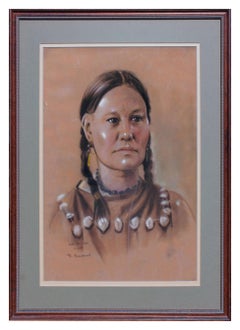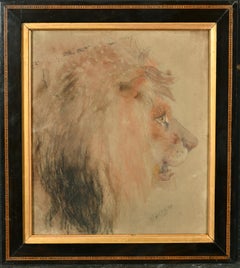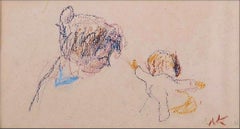Robert Floodstrand Art
American, 1929-1978
Robert Floodstrand studied art at the Art Institute of Chicago, the University of Arizona and Northwestern University. While serving in the Army in Alaska during 1956, he painted many Alaskan landscapes and sold through two galleries in Anchorage. Floodstrand created several hundred pastels, as well as oil portraits.
to
1
1
1
1
1
Overall Height
to
Overall Width
to
1
1
1
1
1
1
6,934
3,279
2,514
1,213
1
1
1
1
1
Artist: Robert Floodstrand
"Ear of Corn, Sioux", Mid Century Native American Portrait
By Robert Floodstrand
Located in Soquel, CA
"Ear of Corn, Sioux", Mid Century Native American Portrait
Beautiful mid century portrait titled "Ear of Corn, Sioux" by Robert Floodstrand (American, 19...
Category
Mid-20th Century Realist Robert Floodstrand Art
Materials
Felt, Paper, Pastel
Related Items
19th century English chalk drawing on paper of a Lions head
By William Huggins
Located in Woodbury, CT
William Huggins was born in Liverpool, England on the 13th of May, 1820. His parents were Samuel and Elisabeth Huggins. He took his first drawing lessons from the Liverpool Mechanics...
Category
1840s Victorian Robert Floodstrand Art
Materials
Pastel, Paper
Free Shipping
H 11.75 in W 10 in
Emily & The Baby II (Grace Borgenicht Gallery)
By Wolf Kahn
Located in New York, NY
Wolf Kahn
Emily & The Baby II (Grace Borgenicht Gallery), 1960
Pastel on Paper.
Hand signed by the artist on the front. Grace Borgenicht gallery label on the back
Vintage frame inclu...
Category
1960s Realist Robert Floodstrand Art
Materials
Pastel
Paysanne Nouant son Foulard (Peasant Arranging her Scarf)
By Camille Pissarro
Located in New Orleans, LA
This intimate work by Camille Pissarro represents a period of significance for the Impressionist master. The early 1880s was a time of great experimentation for the artist, after he spent much of the preceding decade devoted to landscape painting. Shifting focus, he embarked on a series of works in a range of media dedicated to the human figure - particularly peasant women. In watercolor, gouache, pastel, and print, Pissarro captured the rural female and the minute moments of domestic life.
Depicting a peasant woman tying her scarf, Paysanne Nouant son Foulard displays the harmony of color and composition that typifies his work of the 1880s. Composed of a symphony of color and strokes of paint, the work exemplifies the plein air technique of Pissarro's best Impressionist canvases.
A true master of his art, no other artist successfully chronicled rural peasant life quite like Pissarro. Counted among the most respected artists of the 19th century and widely considered the father of Impressionism, Pissarro’s works experienced a surge in interest in the early 2000s. This is reflected in Pissarro’s new auction record of over $32.1 million, set at a 2014 Sotheby’s auction in London, which far surpassed his previous record of $14.6 million.
Born in St. Thomas in the Danish West Indies, Pissarro was sent to school in Paris at the age of 11, where he first displayed a talent for drawing. In 1855, having convinced his parents of his determination to pursue a career as an artist rather than work in the family shipping business, he returned to Paris where he studied at the Académie Suisse alongside Claude Monet. At the outbreak of the Franco-Prussian War in 1870, Pissarro moved to England. With Monet, he painted a series of landscapes around South-East London and studied English landscape painters in the museums. When he returned home to Louveciennes a year later, Camille discovered that all but 40 of the 1500 paintings he had left there - almost 20 years of work - had been vandalized.
In 1872, Camille settled in Pontoise where he remained for the next 10 years, gathering a close circle of friends around him. Gauguin was among the many artists to visit him there and Cézanne, who lived nearby, came for long periods to work and learn. In 1874, Pissarro participated in the first Impressionist exhibition...
Category
Late 19th Century Impressionist Robert Floodstrand Art
Materials
Pastel, Paper
Rare Modernist Hungarian Rabbi Pastel Drawing Gouache Painting Judaica Art Deco
By Hugó Scheiber
Located in Surfside, FL
Rabbi in the synagogue at prayer wearing tallit and tefillin.
Hugó Scheiber (born 29 September 1873 in Budapest – died there 7 March 1950) was a Hungarian modernist painter.
Hugo Scheiber was brought from Budapest to Vienna at the age of eight where his father worked as a sign painter for the Prater Theater. At fifteen, he returned with his family to Budapest and began working during the day to help support them and attending painting classes at the School of Design in the evening, where Henrik Papp was one of his teachers. He completed his studies in 1900. His work was at first in a post-Impressionistic style but from 1910 onward showed his increasing interest in German Expressionism and Futurism. This made it of little interest to the conservative Hungarian art establishment.
However, in 1915 he met the great Italian avant-gardist Filippo Tommaso Marinetti and the two painters became close friends. Marinetti invited him to join the Futurist Movement. The uniquely modernist style that he developed was, however, closer to German Expressionism than to Futurism and eventually drifted toward an international art deco manner similar to Erté's. In 1919, he and his friend Béla Kádar held an exhibition at the Hevesy Salon in Vienna. It was a great success and at last caused the Budapest Art Museum to acquire some of Scheiber's drawings. Encouraged, Scheiber came back to live in Vienna in 1920.
A turning point in Scheiber's career came a year later, when Herwarth Walden, founder of Germany's leading avant-garde periodical, Der Sturm, and of the Sturm Gallery in Berlin, became interested in Scheiber's work. Scheiber moved to Berlin in 1922, and his paintings soon appeared regularly in Walden's magazine and elsewhere. Exhibitions of his work followed in London, Rome, La Paz, and New York.
Scheiber's move to Germany coincided with a significant exodus of Hungarian artists to Berlin, including Laszlo Moholy-Nagy and Sandor Bortnyik. There had been a major split in ideology among the Hungarian avant-garde. The Constructivist and leader of the Hungarian avantgarde, Lajos Kassák (painted by Hugó Scheiber in 1930) believed that art should relate to all the needs of contemporary humankind. Thus he refused to compromise the purity of his style to reflect the demands of either the ruling class or socialists and communists. The other camp believed that an artist should be a figurehead for social and political change.
The fall out and factions that resulted from this politicisation resulted in most of the Hungarian avant gardists leaving Vienna for Berlin. Hungarian émigrés made up one of the largest minority groups in the German capital and the influx of their painters had a significant effect on Hungarian and international art. Another turning point of Scheiber's career came in 1926, with the New York exhibition of the Société Anonyme, organized by Katherine Dreier. Scheiber and other important avant garde artists from more than twenty-three countries were represented. In 1933, Scheiber was invited by Marinetti to participate in the great meeting of the Futurists held in Rome in late April 1933, Mostra Nazionale d’Arte Futurista where he was received with great enthusiasm. Gradually, the Hungarian artists began to return home, particularly with the rise of Nazism in Germany. Kádar went back from Berlin in about 1932 and Scheiber followed in 1934.
He was then at the peak of his powers and had a special flair in depicting café and cabaret life in vivid colors, sturdily abstracted forms and spontaneous brush strokes. Scheiber depicted cosmopolitan modern life using stylized shapes and expressive colors. His preferred subjects were cabaret and street scenes, jazz musicians, flappers, and a series of self-portraits (usually with a cigar). his principal media being gouache and oil. He was a member of the prestigious New Society of Artists (KUT—Képzőművészek Új Társasága)and seems to have weathered Hungary's post–World War II transition to state-communism without difficulty. He continued to be well regarded, eventually even receiving the posthumous honor of having one of his images used for a Russian Soviet postage stamp (see image above). Hugó Scheiber died in Budapest in 1950.
Paintings by Hugó Scheiber form part of permanent museum collections in Budapest (Hungarian National Museum), Pecs (Jannus Pannonius Museum), Vienna, New York, Bern and elsewhere. His work has also been shown in many important exhibitions, including:
"The Nell Walden Collection," Kunsthaus Zürich (1945)
"Collection of the Société Anonyme," Yale University Art Gallery, New Haven, Connecticut (1950)
"Hugó Scheiber: A Commemorative Exhibition," Hungarian National Museum, Budapest (1964)
"Ungarische Avantgarde," Galleria del Levante, Munich (1971)
"Paris-Berlin 1900-1930," Centre Georges Pompidou, Paris (1978)
"L’Art en Hongrie, 1905-1920," Musée d’Art et l’Industrie, Saint-Etienne (1980)
"Ungarische Avantgarde in der Weimarer Republik," Marburg (1986)
"Modernizmus," Eresz & Maklary Gallery, Budapest (2006)
"Hugó Scheiber & Béla Kádár," Galerie le Minotaure, Paris and Tel Aviv (2007)
Hugó Scheiber's paintings continue to be regularly sold at Sotheby's, Christie's, Gillen's Arts (London), Papillon Gallery (Los Angeles) and other auction houses.
He was included in the exhibition The Art Of Modern Hungary 1931 and other exhibitions along with Vilmos Novak Aba, Count Julius Batthyany, Pal Bor, Bela Buky, Denes Csanky, Istvan Csok, Bela Czobel, Peter Di Gabor, Bela Ivanyi Grunwald, Baron Ferenc Hatvany, Lipot Herman, Odon Marffy, C. Pal Molnar...
Category
Early 20th Century Modern Robert Floodstrand Art
Materials
Paper, Charcoal, Pastel, Watercolor, Gouache
Untitled (Man in Blue Tank Top)
By Mark Beard
Located in New York, NY
Pastel and conté crayon with partial foil star on Rives BFK paper
Signed and dated, l.r.
This artwork is offered by ClampArt, located in New York City.
Mark Beard, born in 1956 in ...
Category
1970s Realist Robert Floodstrand Art
Materials
Foil
Portrait of Woman in Pearl Necklace
By Charles Camoin
Located in London, GB
'Portrait of Woman in Pearl Necklace', pastel on fine art paper (see information below), by Charles Camoin (circa 1920s) dedicated to Marie-Louise Tavernier. Regrettably, research on...
Category
Early 20th Century Expressionist Robert Floodstrand Art
Materials
Paper, Pastel
Portrait of a Lady - Late 18th Century European Pastel
Located in London, GB
European School
Late 18th Century
Portrait of a Lady
Pastel on paper, mounted on canvas
Image size: 28 x 23 inches
Contemporary style frame
Provenance:
Ernst Museum Auction
This pastel portrait of a lady dates from the late eighteenth century. She is pictured in a white muslin dress...
Category
Late 18th Century Robert Floodstrand Art
Materials
Laid Paper, Pastel
Portrait Of Lady With Hat - Pastel and Felt on Paper - 1970s
By Olga Klein Astrachan
Located in Roma, IT
Portrait Of Lady With Hat is an original artwork realized by Olga Klein Astrachan.
Pastel and felt on paper stuck on canson paper (26 x 20 cm)
Hand-signed by the artist on lower ...
Category
1970s Contemporary Robert Floodstrand Art
Materials
Paper, Felt, Pastel
H 10.08 in W 7.52 in D 0.08 in
"Head Study 1, " Pastel Drawing
Located in Denver, CO
Yuriy Ibragimov's "Head Study 1" is an original, handmade pastel drawing that depicts a woman's ivory face, with sharp cheekbones and downcast eyes, em...
Category
2010s Realist Robert Floodstrand Art
Materials
Pastel, Paper
Saudi Arabia King Faisal Time Magazine Cover - Man of The Year Study
By Bob Peak
Located in Miami, FL
Master portrait artist and illustration legend Bob Peak captures the likeness, dignity and essence of Saudi Arabia's King Faisal for Time Magazine Cover ...
Category
1970s Realist Robert Floodstrand Art
Materials
Archival Paper, Pastel
H 20.2 in W 13.75 in D 1 in
The Milky Way - Drawing by Mino Maccari - 1975
By Mino Maccari
Located in Roma, IT
The Milky Way is a charcoal and pastel drawing realized by Mino Maccari (1924-1989) in 1975.
Hand-signed on the lower margin.
Good condition on a little paper.
Mino Maccari (Sien...
Category
1970s Contemporary Robert Floodstrand Art
Materials
Paper, Charcoal, Pastel
[Portrait of a Man]
By Ricardo Cinalli
Located in Boston, MA
Signed and dated top right: "Cinalli / MCMXCVII".
Ricardo Cinalli was born in Froylan Palacios in the province of Santa Fe, Argentina. He studied Psychology at the University of Rosario, and previously studied Painting at the Academia Fornells and Piano at the Conservatorio Chopin.
He moved to London in 1973 to study Painting at the Harrow School of Art and later on at Hornsey School of Art. In 1980 he started to exhibit his works in various galleries and museums in Europe, North and South America and Australia. Amongst his public commissions are frescoes in the Londersborough Room in Alexandra Palace, Vintners Place in London, and the Argentinian Embassy among others.
He has created the set designs for Les Parents Terribles by Jean Cocteau for the National Theatre, London (1996), Daphnis and Chloe by Maurice Ravel at the Teatro Municipal de Rio de Janeiro (1998) and Le Nozze di Figaro at the Teatro Colon...
Category
Late 20th Century Realist Robert Floodstrand Art
Materials
Pastel
Robert Floodstrand art for sale on 1stDibs.
Find a wide variety of authentic Robert Floodstrand art available for sale on 1stDibs. You can also browse by medium to find art by Robert Floodstrand in crayon, fabric, felt and more. Not every interior allows for large Robert Floodstrand art, so small editions measuring 19 inches across are available. Customers who are interested in this artist might also find the work of John Sergeant, Gustave Poetzsch, and Margaret Sweet Johnson. Robert Floodstrand art prices can differ depending upon medium, time period and other attributes. On 1stDibs, the price for these items starts at $699 and tops out at $699, while the average work can sell for $699.
Artists Similar to Robert Floodstrand
Robert Sargent Austin, R.A., P.R.E., P.R.W.S.


